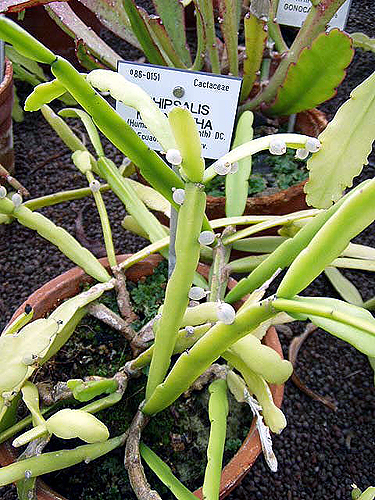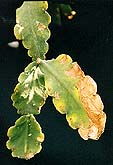|

R. roseana HBG*

R. micrantha ssp rauhriorum

R. roseana HBG
*Huntington Bot. Gdn
|
See
Calvente thesis 2010
7.3. Rhipsalis micrantha subsp. rauhiorum (Barthlott)
Calvente, stat. nov.
Rhipsalis rauhiorum Barthlott, Trop. Subtrop. Pflanzenwelt
10: 15. 1974.
Rhipsalis micrantha f. rauhiorum (Barthlott) Supplie,
Rhipsalidinae: 101 . 1994. Rhipsalis micrantha f. rauhiorum
(Barthlott) Barthlott & N.P.Taylor, Bradleya 13:62. 1995.-TYPE:
ECUADOR. "tal des Rio Catamayo", 1300 m, Sept. 1973, Rauh
35278 (holotype: HEID702584!; isotype: HEID702585!, HNT!).
Terrestrial or rare epiphyte in sunny habitat, 0.8 m long, branching
apical or sub-apical. Stem segments flattened to triangular, rarely
quadrangular in longitudinal section, 1.5-3 mm diam, olive green, succulent,
monomorphic, 5-14 cm long, base attenuate, apex truncate; wings 2-3(-4),
sometimes discontinuous, 0.4-1 cm wide, margin crenate, plane, with
1-4 mm projections, midrib 3-4 mm diam, cylindric. Areoles between margin
projections, 1-3.5 cm apart, first of segment 1-5 distant from segment
base; when sterile 2 mm diam, with vestigial scales; when fertile 1.5
mm diam, with 1-2 acicular scales and scarce hairs at margin, 1(-2)
flowers/fruits. Flowers ca. 9.5 mm diam; pericarpel 3-3.5 X 2.5-3 mm,
cylindric, greenish, glabrous or with sepaloid bract; with 1-3 sepaloid
tepals, 0.3-1.2 mm long and 7 petaloid tepals, 4-5 X 2.3-2.7 mm, oblong
to ellptic, patent or sub-erect, greenish yellow, apex rounded, slightly
cucullate to straight, margin straight. Style 4 mm long; stigma with
4-5 lobes, 1.5 mm long, ligulate, curved, sub-reflexed. Ovules in 4
rows, funicle short (< 0.5 mm long). Stamens ca. 40, 1.5-3.5 mm long,
internal shorter, internal facing outwards and external facing inwards,
whitish. Nectary ca. 0.5 mm. Fruit 7 X 5-6 mm, globoid, whitish, sometimes
with reddish apex, glabrous. Figure 7: F, K.
Notes. Rhipsalis micrantha subsp. rauhiorum is distinct
from the other four subspecies of Rhipsalis micrantha by the
wider wings with margins with deeper projections.
Habitat and distribution: This species is restricted to the Catamayo
River Valley, in Loja (Ecuador), occurring in mostly arid formations,
ranging from 1600-1700 m. Figures 8, 9.
Rhipsalis rauhiorum BARTHLOTT, Trop. Subtrop.
Pflanzenw. 10: 15. 1974
Now treated as a form of R. micrantha in Bradleya 13/1995
Note to the title : This species is named after WERNER and HILDE RAUH,
who discovered it during a joint excursion in the valley of the Rio
Catamayo (South Ecuador) in September 1973
Plant epilithic, hanging over, bushy, up to 1 m long, branching richly
acrotonically (occasionally also mesotonically); sometimes building
whorls.
Shoots 2-sided (primary branches 3- to 4-sided), leaf-like flattened,
succulent. Shoots strongly crenate, 1,9-2,2 cm wide and 5 – 10
cm long with yearly determinate growth (pic 10-12).
Areoles very small, without bristles and with barely visible tomentum;
only new growth with insignificant delicate deciduous leaf .
Branch epidermis dull green with ca. 70 x 100 µ big cells and
smooth surface; stomata not sunken.
Flowers lateral on younger shoots, single or sometimes with two, whitish
(because of the sometimes intensive colored disc often with a red centre),
radial, 7-11 mm in diameter and 8-9 mm long.
Petals 5 to 9, whitish transparent, elongated acuminate, the innermost
up to 5 mm long and 2,5 mm wide.
Style erect, 4 mm long, with mostly 4 back curved lobes. At the base
of the flower a well formed, whitish to mostly carmine disc. Stamens
25 to 35, 2-3,5 mm long, anthers small, whitish.
Pollen 6- to 8-colpat, round, ca. 50µ diameter (pic. 22); Colpi
ca. 20 µ long. Exine (pic. 25) closer as with Rh. micrantha
(HBK)DC with ca. 0,3µ long spinules, near (or next to) the
regular superficial punctures with irregular tectal perforations.
Pericarp lightgreen, naked, only seldom with vestigial areoles, not
sunken in the stem.
Fruit a spherical, naked, ca. 7 mm long and 5,5 mm thick, dirty white
berry, often with a red overlay.
Seeds ca. 25-35 per berry, blackbrown, elongated oval, ca. 1,4 mm long
and 0,6 mm broad with a basal oval hilum. Testa completely smooth with
ca. 90 – 150 µ long and 40 µ wide cells without secondary
structure (pic. 17b).
Chromosomes 2n=22 (extracted from root ends).
Habitat : epiphytic on old trees in raingreen Ceiba pentandra forest
of the Rio Catamayo valley (South Ecuador) at 1300 m altitude;
Holotype : RAUH & BARTHLOTT No. 35278 in the herbarium of the Institutes
für Systematische Botanik der Universität Heidelberg. Clonotypes
are to be founded in culture in the Botanical Garden of the University
of Heidelberg, the succulent collection of the city of Zurich and in
some other collections.
Rhipsalis rauhiorum is a very remarkable species, which in
its habitat reminds of Zygocactus truncatus. The specimens
that have been collected in Ecuador in September, have flowered abundantly
in culture in December. In its habitat the species is accompanied by
xeromorph Bromeliaceae like Vriesea espinosa, V. barclayana, Pitcairnia
spec. (aff. P. pungens), Tillandsia capillaris, T. disticha,
T. latifolia var divaricata, and others. Rh. rauhiorum
appears to be a very variable species. From East Ecuador we obtained
a remarkable, very elegant form with rose-coloured berries (RAUH &
BARTHLOTT 34737); it was found at an altitude of 1000 m near Puyo (Oriente)
by JOEL BRENNER. A very divergent form with longer, leaf-like flattened
stems grows in North Peru on the west slopes of the Andes, between 1200
and 1700 m altitude, near the road to Ayabaca, epiphytic on old trees
(pic. 9) and on Gymnocereus (Browningia) microspermus (RAUH & BARTHLOTT
No. 35307 and 35308).
Rhipsalis roseana BERGER from Columbia and Costa Rica is
to be considered as a closely related species,. According to its original
diagnosis and the cultivated Columbian plants (BG HEID No 35981 from
the MARNIER-LAPOSTOLLE collection) this species distinguishes itself
by its smaller and thinner stems and the form of the flowers as well
as by the colour of the ripe fruit. Rh. rauhiorum is –
compared to Rh. roseana – a xenomorph habitant of the
(for the genus Rhipsalis) extreme dry biotopes. On the other
side it appears to go from Rh. rauhiorum via the larger, flattened
intermediate forms to Rhipsalis goebeliana (HORT.?) BACKBG.,
which up to now was only known in culture. Here we can find probably
the origin of the subgenus Phyllorhipsalis.
Previous Page |